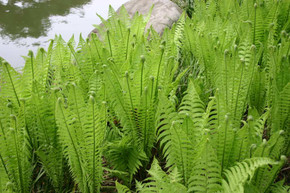
Dryopteris x australis - DIXIE WOOD FERN
Quite rare naturally occurring hybrid of native Dryopteris celsa and Dryopteris ludoviciana.
Very upright, very slowly spreading, semi-evergreen in warmer zones, very adaptable to moisture.
Usually sterile and has to be propagated from divisions or tissue culture.
Blooming Time: doesn't flower
Size: 4' tall x 2' wide (in ideal conditions 5' tall x 3' wide)
USDA Zones: 5 to 9
Culture: part sun (with more consistent moisture), partial shade to shade, soils with organic material or organic mulch (leaf debris), medium moist to moist, neutral or acidic. Established plants tolerate droughts, but are happier with more moisture.
Moisture Needs: average (medium), medium-moist, medium-dry to dry
Origin: native to AL, AR, GA, LA, MD, MS, SC, TN, VA. Natural environments include deciduous forests, moist areas, swamps, but it's know from only a very few locations.
Deer / Rabbit Resistant: yes / yes
Attracts Butterflies or Pollinators: no / no
Attracts Hummingbirds: no
Pot Size: square 3.5" x 4" perennial pot
Plant Combinations: It's good to choose area sheltered from the winds. Can be combined with any half shade or shade tolerant plant like Actaea (Cimicifuga), Alchemilla, Anemone japonica, Bergenia, Brunnera, Digitalis, Epimedium, hardy Geranium, Hosta, Persicaria, Primula, Polygonatum, Salvia koyame, and grasses like Carex (both narrow and wide- leaved), Deschamspia, or Hakonechloa. Good with spring ephemerals and bigger bulbs (Narcissus).
Picture copyright : Bob Doerr, Longwood Gardens

Dryopteris x australis - DIXIE WOOD FERN
Quite rare naturally occurring hybrid of native Dryopteris celsa and Dryopteris ludoviciana.
Very upright, very slowly spreading, semi-evergreen in warmer zones, very adaptable to moisture.
Usually sterile and has to be propagated from divisions or tissue culture.
Blooming Time: doesn't flower
Size: 4' tall x 2' wide (in ideal conditions 5' tall x 3' wide)
USDA Zones: 5 to 9
Culture: part sun (with more consistent moisture), partial shade to shade, soils with organic material or organic mulch (leaf debris), medium moist to moist, neutral or acidic. Established plants tolerate droughts, but are happier with more moisture.
Moisture Needs: average (medium), medium-moist, medium-dry to dry
Origin: native to AL, AR, GA, LA, MD, MS, SC, TN, VA. Natural environments include deciduous forests, moist areas, swamps, but it's know from only a very few locations.
Deer / Rabbit Resistant: yes / yes
Attracts Butterflies or Pollinators: no / no
Attracts Hummingbirds: no
Pot Size: square 3.5" x 4" perennial pot
Plant Combinations: It's good to choose area sheltered from the winds. Can be combined with any half shade or shade tolerant plant like Actaea (Cimicifuga), Alchemilla, Anemone japonica, Bergenia, Brunnera, Digitalis, Epimedium, hardy Geranium, Hosta, Persicaria, Primula, Polygonatum, Salvia koyame, and grasses like Carex (both narrow and wide- leaved), Deschamspia, or Hakonechloa. Good with spring ephemerals and bigger bulbs (Narcissus).
Picture copyright : Bob Doerr, Longwood Gardens







